The last oddball at the Indianapolis Motor Speedway
Part 9: Insights about the 90P from one of its designers
Author
- Henri Greuter
Date
- March 9, 2022
Related articles
- March-Porsche 90P - The last oddball at the Indianapolis Motor Speedway, by Henri Greuter
- Introduction
- Part 1: About oddballs
- Part 2: The road towards the 90P
- Part 3: The design
- Part 4: Performance evaluation (1)
- Part 5: Performance evaluation (2)
- Part 6: Final reflections
- Part 7: Specifications
- Part 8: Results
- March-Alfa Romeo 90CA - Fiasco Italo-Brittanico, by Henri Greuter
- Porsche - Weissach's single Grand Prix win, by Mattijs Diepraam/Felix Muelas
Who?John Andretti What?March-Porsche 90P Where?Brumos Collection, Jacksonville, FL, USA When?2022 |
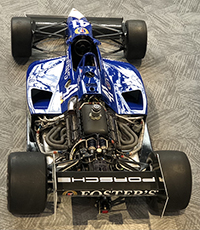 |
Why?
The March 90P is rightfully regarded as a most unusual car about which much can be said. However, due to its limited success, attention to its details and the origins of its principles have never been given much attention. Most of that went to the controversial politics to which the car fell victim.
One of the men behind the 90P's design was Tino Belli, at the time employed by March and assigned to the Porsche project.
During the Month of May in 2016, I had the opportunity to talk with Mr Belli about the 90P in particular. That is how I found out that more obstacles troubled the 90P's basic design and ensured that the car was never built and used as envisioned by its designers from the outset.
According to Belli, the March-Alfa project was run from the Ralt factory in Colnbrook while the Porsche project was carried out in the original March factory at Bicester. But there wasn't much communication between the two projects. Belli had the feeling that Porsche really wanted a dedicated design group, and so there were actually quite a few Porsche engineers in Bicester working on the programme.
Tino Belli had been involved with the 1989 car, the 89P, as well. That car was an evolution of the 88C although there wasn't much time available to be really innovative. It still differed from previous generations of March Indycars since 1981. These started out with very bulbous noses that were retained on later cars. From 1986 on, however, these became narrower. On the 89P, the cockpit was lowered and the big windscreen was gone, a trend in F1 that March was following. But there hadn't been enough time to minimize the design of the car to the limit. The 89P carried a robust gearbox, which later appeared on the Galmer Indycar as well. All together, the 89P ended up being quite a good car but Belli points to another detail about the 89P that is worth mentioning:
"Finally, when you look at the 89P, you’ll notice that the pop-off valve was perpendicular to the airflow coming out of the turbo. And that was intentional because when you blow across the pop-off valve you create low pressure on the inside and so you can get a little more boost. But that made the pop-off valve stick out in the air stream like a sword! It was actually almost not on the plenum, it was so far back towards the turbo that you could argue it was on the pipe that connected the turbo to the plenum. And so Porsche were making some good gains."

I didn't take a lot of decent pictures of the 89P at Indy in 1989. This is the best I can provide to show how far back on the 89P the pop-off valve was located. (photo HG)
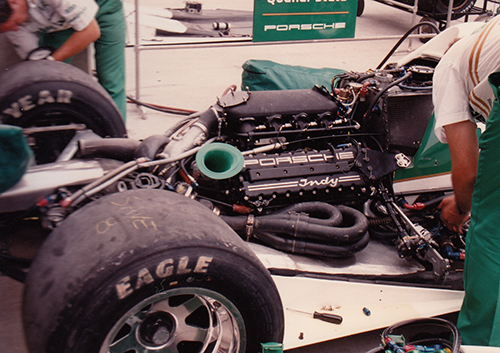
This is a better picture from 1989 showing where the pop-off was located on the inlet plenum of the Porsche Indy V8 engine. But this picture has an imperfection too. Most readers probably won't notice but this is not an 89P! The Porsche team had also brought along an 88C that year, and that is the car pictured here. (photo HG)
This location of the pop-off valve was also to be used on the new car.
Tino Belli and Gordon Coppuck were the joint designers of the 89P's follow-up, with Belli responsible the aerodynamics of the car. As a package, the 90P was minimized as much as possible. This was possible due to the fact that the car wasn't a customer car project that needed to be suitable for all takers. Porsche driver Teo Fabi was a fairly tiny diver and designing a car around his body figure meant that the resulting car could be very low and small. It did however limit the options as to who was hired to drive the second car. Eventual choice John Andretti was another tiny driver who easily fitted within the confines of the car. In a talk with John I had in 2011, as well as in his biography, John said that the 90P's final design was based more on Teo's body dimensions than those of his own. Even for John the resulting car was a very tight fit.
In particular, the concept of the car was unusual with respect to the location of the turbocharger. When I asked Belli who came up with that suggestion and the idea behind it, he had the following to tell:
"Porsche wanted it. They insisted on having absolutely equal length primaries and secondaries on the exhaust system. And for us at the time that was very difficult to do with the turbo in the bellhousing. Then Gordon Coppuck came up with the idea of putting the turbo on the front. I think it was the Toleman in '84, a simple Formula 1 car with a Brian Hart-engineered single turbo up front, that gave him the idea. And we found out we could make the secondaries exactly the same length far easier and shorter. They wanted them to be very, very short."
It also resulted in a situation in which the turbo sat very low down in front of the engine. And if the manner of locating the pop-off as used on the 89P was repeated, it would lead to a situation that the pop-off was located in front of the engine, shrouded within bodywork, underneath the engine cover and still blowing the air perpendicularly across the pop-off valve and the into the plenum.
What appeared to be a bright idea with some good advantages then fell foul to a sudden rule change by CART, other than the commonly known rule change that killed off the 90P design's potential. Belli explained that CART came up with a number of rule changes that took away a lot of the 90P's potential advantages. The first of these rule changes was CART deciding that they didn't want to offer the ability to have the pop-off valve anywhere you wanted on the plenum. Instead, CART mandated it had to be on the intersection between cylinder one and the two corner cylinders. On the 90P, this meant that the opportunity to hide the pop off deep within the car was suddenly forbidden, and instead it now went into the middle of the engine cover, sticking into the air again. So the 90P lost the advantage of its ideal pop-off valve location, with a power loss as a result, and with it, some of the advantages of having the turbo in the front, while all the negative aspects of that feature remained.
One of those disadvantages was the heat distribition within the car as well as the way in which to get exhaust gases out of the turbo without damaging the engine cover. The latter issue was rated by Belli as one of the car's Achilles heels.
So now you've heard about a much less known CART rule change for the 1990 season which severely affected the 90P's performance. Of course, the 90P became much better known for another rule change of which it fell victim and for which it was in fact the reason: the ban on using all-carbon monocoques.
Thanks to the experience with the Formula 1 cars of the company, enough expertise had been gathered within March by now on how to build a decent an all-carbon monocoque. So it wasn't all that strange that once a window of opportunity opened up to re-introduce the technology in CART it was March that had an interest to do so. The unraced Lotus 96 Indycar that was set to be run by Roy Winkelmann Racing had an all-carbonfibre monocoque, and according to Belli the rules had allowed all-carbon cars prior to 1986. In Belli's own words, this is what happened next:
"And then they had some accidents. So they said, from '86 for three years you had to have either a solid aluminum bottom half of the car or an aluminum honeycomb bottom half of the car, but that was a three-year rule. And so 1990 was the first year when you could go back to the original regulations which said that they had to be equivalent, any material that was equivalent to an aluminum construction. So we spoke with Champcar on it quite extensively and the concern at the time, and the reason given for the aluminum, was the second impact with the wall. So cars were typically going in, hitting the wall, then spinning around and then hitting the wall again. With their nose."
The wingcars of that generation had the drivers far up front in the car, their legs not having much protection from any structural car components in front of the legs. The year 1984 was very hard on a number of drivers crashing March 84C cars and suffering severe injuries.
Once the plan for an all-carbon monocoque was made, March went to Cranfield, the predominant race car crash institution at that time. Everyone did their crash test at Cranfield, nowadays named the Cranfield Impact Center, part of the Cranfield University in Bedfordshire, United Kingdom. The people at Cranfield were informed about CART's worries and were requested to come up with a test protocol that would relay their fears. They came up with a two-impact test. Belli recalled that these were carried out with what must have been an 88C, during which at all distances G-forces were measured. It turned out that the second impact was of a lower intensity than the first one.
By then, CART was approached with the question whether they were OK with an all-carbon monocoque car going through the same crash tests that could absorb the same amount of energy and the same distances with no greater peak forces.
Belli added to this: "We presented that to Champcar and they said yes. So we worked along that principle, they were very aware of what we were doing right from the very beginning."
But as we know by now, all of a sudden things went entirely wrong. And according to Tino Belli, this is what happened:
"One of the race engineers who had been on the Porsche 1989 programme left at the end of '89. He had a bit of a falling out with the Porsche guy from Germany who was in charge of the project. He went to Newman-Haas and told Carl Haas about what we were doing. And then in the owners meeting at Palm Springs in the beginning of January 1990 they changed the regulations to that all-carbon cars were not to be allowed until 1991."
The ban on all-carbon monocoques caused a lot of trouble for the team. The car's underpart had to be redesigned with effectively the bottom of the car clad with a layer of 1/8th-inch aluminum. This made the resulting monocoque and the entire car very heavy, which had its effects on performance, notably on road coarses. The major redesigns of the underpart also meant that the team lost months of development time, and a lot of money as well.
Apart from the issues with the materials required to build the monocoque, the actual 90P monocoque had some unusual design and construction details. For example, the rear part of the monocoque had a large indent in order to accomodate the turbocharger. It was tried, however, to get as much 'material' within this cavity as possible. But also, in the original all-carbon design of the car the big benefit of carbonfibre was that you don't need to basically restrain the design to straight lines only. So the designers sculpted the shape of the bottom of the car, narrowing the bottom itself but making the fuel cell very wide. As a result, it was impossible to install the fuel tank in the manner normally used for Indycars, by removing the rear bulkhead of the monocoque and squeezing in the fuel tank.
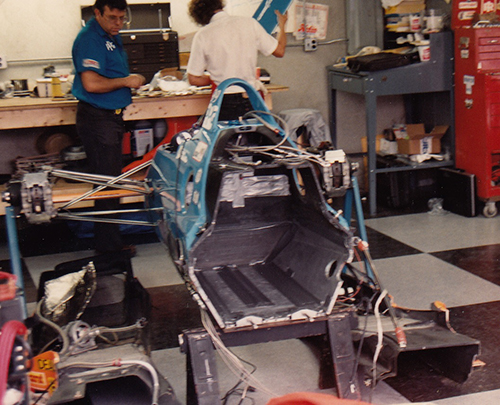
Seen in 1989: Lola T87/00 HU08 without rear monocoque bulkhead and fuel tank. That year it was Gary Bettenhausen's car. (photo HG)
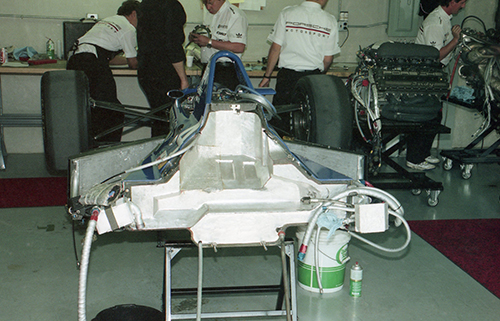
Looking at what must be the rear bulkhead on the 90P, it becomes obvious that a scene shown above with the Lola T87/00 was absolutely impossible. The two pins at the very bottom of the monocoque were mounting points for the engine. (photo HG)
On the 90P, however, the fuel tank had to be inserted from the bottom of the car. Due to the irregular shape of the rear part of the car it was quite a challenge to design and build this fuel tank (designed with CAD technology) and squeeze it into the monocoque. It didn't come off perfectly. As a result, the fuel tank was not of the permitted maximum capacity, while making sure the tank filled all the cavities in the monocoque took some effort and high pressure.
The indent at the rear of the monocoque also had its effects on the manner in which the engine was attached onto the monocoque. Only the bottom part of the monocoque was 'available' to attach the engine onto, and the turbo hung onto a frame that was also used to attach the engine against. Despite that less than ideal manner of connecting, the structural rigidity of the entire chassis & engine combination was still good enough, as the monocoque was rather small which was typically good for torsional rigidity. However, there was still a lot of material to account for, especially in the bottom half, thanks to all the composite material and the aluminum on top of it.
The turbocharger sitting so close to the fuel cell and getting hot did cause some trouble as well. Heat isolation for this was cured thanks to assistance from Porsche Germany. Tino Belli, who was in charge of aero developments, was in contact with Porsche in Weissach for a few days once every three weeks, working on how to integrate the engine into the whole system. Thanks to Porsche Weissach, the team was introduced to a company that Belli remembered as 'G & H Montage'. They provided an isolation material built up from two layers of stainless steel foil and ceramic paper in between the foils. This material worked so well that if a car pitted and the engine cover was taken off it was possible to put your hands onto the turbo for a few seconds without wearing a protective glove. It was a material of which Belli was still in awe 26 years later. It has to be mentioned that despite the potential hazardous design none of the cars ever suffered a fire in the engine bay.
As for the aerodynamics on the car, these were kind of interesting thanks to that hot exhaust flow above the sidepod on the left side of the car. According to Belli, there was no instrumentation around to sort out the effects of that arrangement, like, for example, if there was a difference in downforce levels for the left and right side of the car.
The car's windtunnel model was fitted with air movers in order to resemble this effect, but the effects of temperature differences were difficult to imitate. Nevertheless, the basic design of the car did have some advantages. In terms of drag there was almost no frontal area, and perhaps it may say something about its aero efficiency when you are aware that the 90P was the fastest non-Chevy-powered car in qualifying at Indy. And then remember that at Indy it was still at its heaviest as it was used during the 1990 CART season.
Without a turbo to accomodate between the engine and rear axle, this allowed the use of a bespoke design gearbox to assist aerodynamics and weight distribution. The transmission had a forward longitudional gearbox so all the gears were in front of the differential. A step-up gear helped to get the shafts in line to the crown and pinion. This enabled an increment of the size of the diffuser at the rear. Tino Belli remembered the transmission having a very V-shaped bottom.
The oil tank was wrapped around the gears on the right side. It was cast in and oiling was definitely an issue for the car. At some tracks, because the oil tank wasn't very high, maintaining oil pressure was quite difficult. In fact, the 90P oil tank was among the only oil tanks of the era with a floating pickup. It had a pipe that could swing to follow the acceleration and so trying to stay in the oil too in order to get the pickup. This principle wasn't very commonly used in racing cars at the time.
All combined, the Porsche Indycar team was troubled by a compromised car of a fairly complicated design and thus was stuck with a car destined never to reach its full potential, with all its issues ironed out. With hindsight, the entire concept of the car was probably too ambitious, not to mention all the handicaps that the car was handed after the monocoque specs had to be changed. Innovative as it was, there were also a number of impractical details on the car.
And if all of that wasn't enough, the Porsche company had its own difficulties to sort out which had a knock-on effect on the long-term strategy of its racing programmes. The CART project's future became in jeopardy because of it. On top of that, partner March ran into serious difficulties endangering the sheer existence of the company at the end of the year.
When I asked Mr Belli about the future of the 90P if Porsche had continued the Indycar programme, he answered that this was never discussed. In fact, Belli believed that after the rule change on all-carbon cars it was quite obvious that Porsche was to see out the season before quitting the project. He believed there was never any discussion on what to do beyond 1990.
When I mentioned that it would have been interesting to see what the Porsche engine could have done in a Lola chassis, I got a surprising answer. In Belli's own words:
"Yes, it was a very good engine. In '89 I think it was not as competitive as probably the Chevy was. But in '90 it definitely was. They had some new people coming in and they worked through, we saw good progression even through '89 on the engine. Particularly when I think they hurt the engine quite a lot when they made the pop-off valve move. But there was a very good progression and I think the 1990 motor was very, very good. I think it was probably the best that year."
However, the 90P became a victim of politics. Carl Haas and Roger Penske saw themselves put on the back foot by a competitor that had beaten them to a new technology, and with Champcar being owned by all the car owners, they were in a position to have the rules changed to protect their own interests. Porsche protested quite hard that changing the rules that late in the game really wasn't fair but it was to no avail. And although a lot of the blame has been put in Roger Penske's lap, it needs to be remembered that once Carl Haas was informed about what was going on at Porsche and March when this Porsche engineer joined his team, he was a big factor too in what happened. Fair or not, it was the American way, due to the culture differences between the USA and, say, Europe. Belli described this in a nice manner:
"It's a different culture how they [the Americans, HG] approach it. I approach it very much the European way. Which is: 'here are the rules'. If you find a way around the rules or find a loophole in the rules, exploit it and everyone says well done. Whereas the American way is more like: 'no, not well done, you should have told us you've found a loophole, then we could close it'. And it's a difference between entertainment and sport. I think in Europe we see motorsport very much as a sport, not necessarily entertainment. And I think in America most sports are seen more as entertainment."
So there you have it. Entertainment. Entertainment potentially being ruined because of one team having an advantage after having read the rules and understanding the options within those rules better than others, and being in the position to go for that advantage. What a reason to ban innovation in racing.
The fact remains that, be it because of the need to assure entertainment or for whatever other imaginable reason, co-designer Tino Belli saw his brainchild, one of CART's most innovative cars ever, being banned before it only ran in a modified form that was never able to live up to its expectations.
Nevertheless, despite everything, the 90P remained one of Tino Belli's favourite cars with which he has been involved, and he has more than enough reasons for that.
A special word of thanks to Tino Belli for the time and efforts invested resulting in this publication.
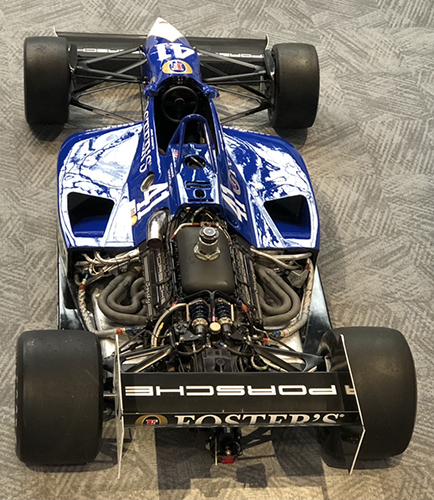
The memory and legacy of the March-Porsche 90P has recently been kept alive with a new addition to the Brumos Collection at Jacksonville FL. This is chassis 90P-005 that was acquired by this museum in the fall of 2021 and went on display shortly thereafter. (photo copyright Paul Barr, used with permission)
